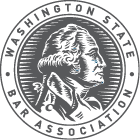Professional Liability Insurance
Lawyers │ LLLTs │ LPOs
Lawyers – Washington Supreme Court Admission and Practice Rule 26
Washington lawyers are not required to have professional liability insurance coverage. However, they are required to report to the Washington State Bar Association, on a yearly basis, whether they have coverage. They are not required to report the following:
- Who their insurer is, if they have malpractice insurance coverage.
- The limits of their policy.
- The amount of any deductible that the lawyer must pay before the insurance company is obligated to pay a claim.
- Any limitations on or exemptions from coverage. For example, most legal malpractice insurance policies do not cover claims against a lawyer that arise out of illegal conduct by the lawyer.
Not all lawyers maintain professional liability insurance. Some lawyers may make a responsible decision not to maintain insurance because the lawyer is an in-house or government lawyer, or because the lawyer may choose to be financially responsible (self-insured).
The Washington State Bar Association does not independently verify the insurance information provided by lawyers. There is no guarantee that a lawyer has maintained insurance coverage after the report date or will continue to maintain insurance coverage in the future. There is also no guarantee that a lawyer has adequate insurance limits to cover all potential claims or that a particular claim will be covered by the policy. Note that it is also possible that the information displayed was erroneously reported or incorrectly entered in the State Bar's database.
The following is a list of questions that a prospective client might ask before entering into a lawyer-client relationship with a particular lawyer:
- Do you presently maintain professional liability insurance coverage?
- What is the name of your insurer?
- What are the limits of your coverage? Have any of those limits been used in the payment of other claims?
- What is the deductible under your policy?
- Does your policy cover the type of work you are doing for me?
- What is the term of your current coverage?
- Will you advise me if you discontinue your coverage or change your limits?
- Could you provide me with a Certificate of Insurance (evidence from an insurance company that the lawyer is insured)?
Professional liability insurance policies provide insurance coverage for some but not all professional liability (malpractice) claims made against a lawyer. Most professional liability policies are written on a "claims-made" basis. This is different from the usual home-owners or automobile insurance policy. This means that the insurance company providing the insurance has agreed to cover claims that are made against the lawyer during the term of the policy. In other words, the policy that applies to a particular claim is the policy that is in effect at the time the claim is presented to the insurance company with a demand for payment - not the policy in effect when the lawyer's alleged negligence or mistake took place. Malpractice insurance policies typically limit the amount that the insurance company can be required to pay on each claim and the total amount that the insurance company can be required to pay on all claims made against the lawyer during the term (or effective period) of the policy. The maximum amount of coverage provided by a malpractice insurance policy is called the "limits" of the policy.
LLLTs – Washington Supreme Court Admission and Practice Rule 28
Financial Responsibility. Each LLLT shall show proof of ability to respond in damages resulting from his or her acts or omissions in the performance of services permitted under APR 28 by:
- submitting an individual professional liability insurance policy in the amount of at least $100,000 per claim and a $300,000 annual aggregate limit
- submitting a professional liability insurance policy of the employer or the parent company of the employer who has agreed to provide coverage for the LLLT’s ability to respond in damages in the amount of at least $100,000 per claim and a $300,000 annual aggregate limit; or
- submitting proof of indemnification by the LLLT’s government employer.
LPOs - Washington Supreme Court Admission and Practice Rule 12
Financial Responsibility. Each active limited practice officer shall submit to the LP Board proof of ability to respond in damages resulting from his or her acts or omissions in the performance of services permitted under APR 12 in one of the following described manners:
- Submit an individual policy for Errors and Omissions insurance in the amount of at least $100,000;
- Submit an Errors and Omissions policy of the employer or the parent company of the employer who has agreed to provide coverage for the LPO's ability to respond in damages in the amount of at least $100,000;
- Submit the LPO's audited financial statement showing the LPO's net worth to be at least $200,000;
- Submit an audited financial statement of the employer or other surety who agrees to respond in damages for the LPO, indicating net worth of $200,000 per each limited practice officer employee up to and including five, and an additional $100,000 per each limited practice officer employee over five, who may be subject to the jurisdiction of the Limited Practice Board; or
- Submit proof of indemnification by the limited practice officer's government employer.
Each active LPO shall certify annually continued financial responsibility in the form and manner as prescribed by the Bar. Each LPO shall notify the Bar of any cancellation or lapse in coverage. When an LPO is demonstrating financial responsibility by (1) an endorsement on the employer's Errors and Omissions insurance policy or (2) submission on the employer's audited financial statement accompanied by the Certificate of Financial Responsibility, the Bar shall notify the employer when the LPO's status changes from Active to another status or when the LPO is no longer admitted to practice.






